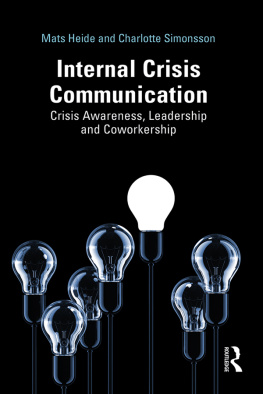IntroBooks Team - Leadership in Turbulent Times
Here you can read online IntroBooks Team - Leadership in Turbulent Times full text of the book (entire story) in english for free. Download pdf and epub, get meaning, cover and reviews about this ebook. year: 2019, publisher: IntroBooks, genre: Business. Description of the work, (preface) as well as reviews are available. Best literature library LitArk.com created for fans of good reading and offers a wide selection of genres:
Romance novel
Science fiction
Adventure
Detective
Science
History
Home and family
Prose
Art
Politics
Computer
Non-fiction
Religion
Business
Children
Humor
Choose a favorite category and find really read worthwhile books. Enjoy immersion in the world of imagination, feel the emotions of the characters or learn something new for yourself, make an fascinating discovery.
- Book:Leadership in Turbulent Times
- Author:
- Publisher:IntroBooks
- Genre:
- Year:2019
- Rating:3 / 5
- Favourites:Add to favourites
- Your mark:
Leadership in Turbulent Times: summary, description and annotation
We offer to read an annotation, description, summary or preface (depends on what the author of the book "Leadership in Turbulent Times" wrote himself). If you haven't found the necessary information about the book — write in the comments, we will try to find it.
Turbulent times occur due to crises, which can happen at any
time and in any organisation. Even if the firm is doing well
today, it does not eradicate the possibility of the firm being
thrown into trouble in the nearest future. No one can predict
the future. While leaders of a company are enjoying the good
times, they should equally consider the possibility of turbulent
times; as a result, they should prepare for eventualities. They
should get themselves ready for those times that crisis will be
the order of the day. No one wishes for crises, but the crisis
does not come by wishing for them; they come a random and
the causes can be internal or external.
Preparing ahead of time can prevent the problems of under
preparation for crises. A company and its management should
understand how to manage crises situations when such arise.
The leaders in a company should be visionary enough to get
them set for any problem that may arise.
There is a clear difference between crises leadership and crisis
management. Company A may thrive in times of crises, while
company B may fail in the same situation. One major factor
that differentiates the two is the quality of leadership being
displayed during such period. A manager should show him or
herself worthy of the place of leadership throughout the
crisis-management process. In this text, emphasis will be laid on
several competencies that a leader should have during crises for
effective crisis management; lacking any of these qualities will
not augur well for the company during those severe downturns.
Leaders should develop top quality corporate communication
strategies and also build a foundation of trust among the
members of staff of the organization and those involved in the
supply chain. The foundation thus built can then be used in
preparing the organization for those difficult times.
The last statement indicates that learning about crisis
management should not start when the problem begins, but
should have been well versed long before such a situation
arises. If well managed, the leader can leverage crises situations
for creating a better organization via change creation. The
organization should also not lag in public relations, which is an
integral part of crisis management. PR activities and
communication should not be limited to the members of the
public, but should also involve and include members of staff;
yes, it is crucial to carry the members of staff along during the
crises situation. Despite the place of importance of
communication and PR activities, they are not sufficient to see
the company through the crisis period; more still needs to be
done. It is essential to build a camaraderie spirit among the
member of staff, which will buy the confidence and image of
the organization among the staff member and the general
public. Transparency and wise management of information are
some of the essential factors a good leader should put into
practice during crises management. Many members of staff will
be more disposed to tag along faithfully if they feel carried
along.
Failure to carry members of staff along can have a foreboding
effect on leadership effectiveness, which will not augur well for
the company. The leaders should see the big picture of the
crisis and be able to spot an opportunity that can help the
organization scale through this uncomfortable situation. It is
mandatory for an organization to be professional and humane
in its crisis...
IntroBooks Team: author's other books
Who wrote Leadership in Turbulent Times? Find out the surname, the name of the author of the book and a list of all author's works by series.














